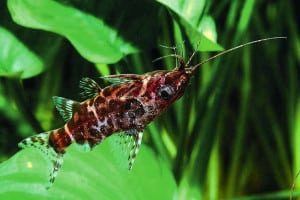
Common name: Upside-down Catfish
Scientific name: Synodontis Nigriventris
Average Adult Fish Size: 4 inches / 10 cm
Place of Origin: Zaire and Niger River basins of Africa.
Typical Tank setup: African biotope with rock work, plants, and some floating plants.
Recommended Minimum Aquarium Capacity: 20 gallon / 80 litre
Compatibility: Peaceful, but will eat very small fish. Do not keep with fish that are large enough to attempt eating it. It will erect its spines and become lodged in the eaters throat.
Temperature: 72 – 80 Deg F / 22 – 27 Deg C
Water chemistry: pH 6.5 – 8.0
Feeding: Mosquito and other insect larvae are the primary food of the Upside Down Catfish and are the best choice of food, though it will eat flakes, small floating pellets, live and frozen brine shrimp.
Sexing: Females are larger, are paler in coloration, and have a plumper more rounded body, particularly when ready to spawn.
Breeding: They prefer cave spawning. An overturned clay flowerpot or two, or even some PVC pipe, may be offered as a possible spawning location. Conditioning with live foods and softening the water to mimic spring rains will increase the odds for success.
Eggs will generally be laid in the roof of the cave. Parents may be left in the tank after spawning, as they will tend to the brood. The eggs hatch in approximately two to three days. The fry will feed off the yolk sack, which they carry for four days.
Once the yolk sack has been consumed, they will begin eating freshly hatched brine shrimp. In two months the fry will begin swimming in the characteristic upside down fashion of adults.
Additional Information: It prefers skimming the surface while swimming upside down for food, but will swim “right-side-up” and cover all levels of the aquarium. Single fish will normally hide in plants, floating plants, or rock work except while eating or searching for food. Groups of this species will keep each other active. They are very easy to keep and are very entertaining. They do not tolerate poor water quality. Frequent partial water changes are needed to keep them healthy. Use a very fine mesh net while moving or catching this fish as its’ spines will become lodged in coarse nets making the fish difficult to remove without injury.


Related Posts
Croaking Gourami – Trichopsis vittatus
Benthochromis Tricoti
Large-eyed Mouthbrooder – Callochromis Macrops